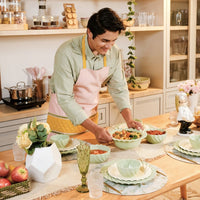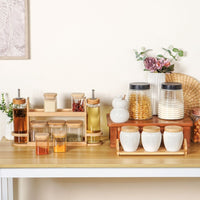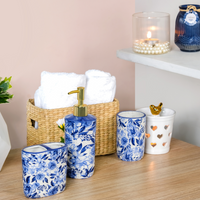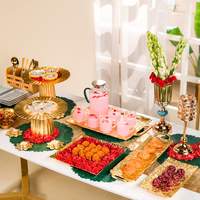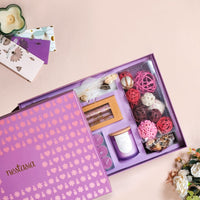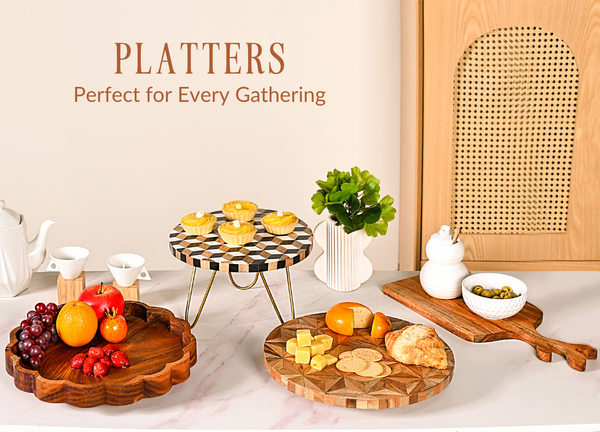Think 'cheeseboard,' and what pops into your mind? Probably a fancy spread with European brie, Italian Parmesan, and a side of traditional crackers, right? While those spreads are undeniably delightful, get ready to hold onto your appetite, because we're about to introduce a delicious secret that’s been hiding in plain sight: India’s incredible array of dairy wonders and zesty accompaniments.
Forget what you thought you knew about platters. Picture this: a cheeseboard where the comforting creaminess of local Indian dairy dances with the bold, aromatic spices, the sweet and tangy notes of regional fruit spreads, and the surprising kick of traditional savouries. This isn't just a snack platter; it’s a flavour adventure, a playful celebration of tastes that are genuinely rooted in the heart of India. It’s an experience that promises to surprise your taste buds and spark lively conversation.
This fresh approach to the classic cheeseboard is far more than just a culinary experiment. It’s a wonderful invitation to rediscover India's diverse dairy heritage. From the distinct cheese-making traditions perfected in the snowy peaks of Kashmir to the unique textures developed in the humid plains of Bengal, various communities across India have crafted cheeses that are simply perfect for pairing.
Get ready to redefine your next gathering with a platter that is truly brimming with authentic Indian charm and unforgettable tastes, a concept this guide fully explores.
The Dairy Jewels of India: Building Your Cheeseboard Foundation
At the core of any exceptional cheeseboard lies the cheese. While India may not be globally renowned for its aged hard cheeses in the same vein as France or Italy, it possesses a fascinating array of fresh and semi-fresh dairy products that are perfect for a different kind of cheeseboard experience. These local Indian cheese varieties offer a spectrum of tastes and textures that are both familiar and surprisingly new.
Paneer: The Beloved Indian Cheese
No discussion about Indian cheese can begin without paneer. This fresh, unripened cottage cheese is a staple in almost every Indian household. It's known for its soft, slightly crumbly texture and mild, milky flavour, making it incredibly versatile.
From rich curries like Paneer Butter Masala to smoky Paneer Tikka and comforting Palak Paneer, countless dishes featuring this beloved cheese have ruled Indian hearts for generations. Unlike many Western cheeses, paneer does not melt easily, retaining its shape beautifully, which makes it a fantastic addition to a cheeseboard. For a cheeseboard, paneer can be presented in several ways. Cubes of plain paneer offer a clean palate cleanser between more intense flavours.
For a more exciting option, consider marinating paneer in a light mix of ginger-garlic paste, a touch of red chilli powder, and a sprinkle of garam masala, then lightly try frying or grilling it for a few minutes in a stainless steel pan. This adds a warm, spiced dimension that pairs wonderfully with sweet or tangy accompaniments. Its ability to absorb flavours makes it a superb base for various spice infusions. The gentle taste of paneer provides a soft contrast to stronger, more assertive flavours on the board, making it a crowd-pleaser for those who prefer milder cheeses.
Kalari Cheese: The Alpine Gem of Jammu & Kashmir
Travel north to the scenic regions of Jammu & Kashmir, and you'll discover Kalari cheese. This traditional local cheese is a true hidden treasure. Often compared to mozzarella or a soft ricotta in its raw state, Kalari cheese transforms beautifully when heated. It develops a delightful chewiness and a slightly elastic texture, sometimes described as squeaky. It has a mild, tangy flavour with a hint of earthy notes, reflecting the pristine environment where it's made.
Traditionally, Kalari cheese is pan-fried in its fat or a little ghee until golden brown and crispy on the outside, with a soft, gooey interior. This preparation method is key to appreciating its unique qualities. On an Indian cheeseboard, serving pan-fried Kalari cheese offers a warm, comforting element. It pairs particularly well with sweet chutneys or a dollop of fruit preserve, allowing its milky richness to shine through against a backdrop of sweetness. Its unusual texture adds a fascinating dimension that guests will remember. The process of making Kalari cheese is often artisanal, contributing to its distinct character.
Bandel Cheese: Bengal's Smoky Secret
From the eastern reaches of India, particularly Bengal, comes Bandel cheese. This unripened, often smoked, cheese boasts a unique character. Traditionally made in small, disc-like shapes, Bandel cheese is crumbly, salty, and often carries a distinct smoky flavour, especially if smoked over husk. Its origins are tied to the Portuguese influence in the region, bringing a different cheese-making technique to Indian shores.
The high salt content of Bandel cheese makes it an interesting component for a truly unique charcuterie board. It acts as a flavour enhancer, much like a sharp Parmesan or feta. To balance its saltiness, Bandel cheese works wonderfully when paired with sweet elements. Think fresh fruits like grapes or figs, or a sweet mango chutney. Its crumbly nature means it can be sprinkled over other elements or served in small pieces for guests to discover. The smoky undertones add depth and complexity, providing a strong counterpoint to the milder paneer or the rich Kalari cheese. It's a taste that transports you to the historical cheese-making traditions of Bengal.
Beyond the Big Three: Exploring Other Indian Dairy Delights
While paneer, Kalari cheese, and Bandel cheese form an excellent foundation for an Indian cheeseboard, the cheese-making traditions across India run deeper. For those looking to expand their cheese horizons, consider:
Chhurpi: A hard, dried yak cheese from the Himalayan regions, offering an intensely savoury, almost umami flavour. While often chewed as a snack, softened pieces can introduce an unexpected element.
Artisanal Goat Cheeses: Several new Indian dairies are producing excellent soft and semi-hard goat cheeses, which can bring a creamy texture and a distinct tangy flavour to the board.
Fresh Cow and Buffalo Milk Cheeses: Many regional areas have their versions of fresh cheese similar to paneer but with slight variations in texture or acidity, offering subtle differences for the discerning palate.
The key is to think about texture and flavour contrasts to build a diverse and appealing platter, perhaps even inspiring a fun fondue set experience. This expanded world of Indian dairy offers endless playful possibilities.
Regional Add-ons: The Indian Flavour Orchestra
A cheeseboard is only as good as its accompaniments, and this is where the Indian twist truly comes alive. The vast culinary diversity of India provides an incredible array of condiments and snacks that perfectly complement the unique characteristics of Indian cheeses.
A World of Chutneys: Sweet, Tangy, and Spicy Harmonies
Chutneys are essential to Indian cuisine, known for their ability to add layers of flavour to any dish. On a cheeseboard, they act as bridges, connecting the richness of the cheese with other elements.
Mango Chutney (Aam Ka Aachar): The classic sweet and tangy mango chutney is a universal favourite. Its fruity sweetness and hint of spice cut through the richness of paneer and can balance the saltiness of Bandel cheese.
Mint Chutney: Fresh, zesty, and often with a kick of green chilli, mint chutney offers a bright, herbaceous contrast. It pairs well with the mildness of paneer and provides a refreshing counterpoint.
Tamarind Chutney (Imli Chutney): This sweet and sour chutney has a deep, complex flavour that works beautifully with cheese, especially with pan-fried Kalari cheese, where its tang can provide balance.
Tomato Garlic Chutney: For those who appreciate bolder flavours, a rustic tomato garlic chutney offers a pungent, savoury option that can stand up to the stronger notes of Bandel cheese or spiced paneer.
Chutneys are the vibrant soul of Indian cuisine, more than just a side dish; they are a direct conversation with your individual palate. Offering a diverse selection of chutneys empowers each person to curate their own symphony of flavours, allowing them to explore and discover the perfect sweet, spicy, tangy, or savoury complement that truly completes their meal.
Khakhra: The Crispy, Light Canvas
Forget the usual water crackers; enter khakhra. This thin, crisp, and often spiced flatbread from Gujarat is a fantastic alternative. Made from wheat flour, khakhra comes in various flavours, including plain, masala, methi (fenugreek), and jeera (cumin).
Its delicate crunch provides a delightful textural contrast to the soft cheeses. Unlike heavier crackers, khakhra is light and doesn't overpower the flavour of the cheese. It acts as a perfect vehicle for scooping up paneer or a dollop of chutney, adding a subtle flavour profile that complements, rather than competes with, the star ingredients. Arranging a fan of different khakhra varieties on a platter adds visual appeal and diverse crunch.
Masala Nuts: Aromatic and Flavourful Crunch
Instead of plain roasted nuts, masala nuts introduce a whole new dimension of flavour and texture. Typically, these are cashews, almonds, or peanuts lightly roasted and tossed in a blend of Indian spices like red chilli powder, turmeric, cumin, and black salt.
The warm, aromatic spices on the nuts add a depth that plain nuts can't. They offer a satisfying crunch and a burst of savoury flavour that contrasts beautifully with the creamy cheeses and sweet chutneys. A small bowl of assorted masala nuts adds both visual interest and an irresistible snacking component to the board.
Pickles A Tangy Kick and Bold Counterpoint
Indian pickles are legendary for their intense flavours and ability to cut through richness. Their acidity, spice, and sometimes sweetness make them surprising, yet incredibly effective, companions for cheese. When starting your journey into these delectable pairings, you can't go wrong with these classics. These tried-and-true varieties are fantastic starting points for their balanced profiles and widespread appeal.
Mango Pickle (Aam ka Achar): The classic sour and spicy mango pickle offers a sharp, tangy kick that can awaken the palate and provide a zesty contrast to creamy paneer or the mildness of Kalari cheese.
Lime Pickle (Nimbu ka Achar): Brighter and zestier, lime pickle brings a citrusy sharpness that cleanses the palate and complements the dairy notes.
Mixed Vegetable Pickle: With a variety of vegetables and spices, a mixed pickle offers a medley of textures and tastes, adding complexity to each bite.
This delightful combo of a small spoonful of pickle and a slice of cheese is perfectly suited for a cheeseboard with bowls, encouraging adventurous tastes and bold Indian flavours.
Sweet Additions and Fresh Produce For a Balanced Board
No cheeseboard is truly complete without a sweet counterpoint to its savoury and tangy notes. It's the perfect way to round out the experience, offering a delightful balance to every bite. Here are a few options you can try.
Fresh Fruits: While grapes and apple slices are standard, consider adding Indian seasonal fruits like lychees, pomegranate seeds (especially beautiful when sprinkled), or even small pieces of fresh dates.
Dried Fruits: Dried apricots, figs, and raisins offer concentrated sweetness and chewy textures that pair well with all types of cheese.
Jaggery (Gur): Small chunks of jaggery, an unrefined sugar, provide an earthy, caramel-like sweetness that is very authentically Indian and pairs wonderfully with the salty Bandel cheese.
Honey Drizzle: A small drizzle of honey, perhaps infused with a touch of cardamom or saffron, can be offered for drizzling over cheese and fruits.
Perfecting Your Indian Cheeseboard Presentation
Crafting an Indian cheeseboard is a delightful art, harmonising exquisite tastes with stunning visual appeal. Here, the presentation is truly as vital as the delicious ingredients themselves. To achieve this balance, here's what you need to keep in mind:
Choose Your Board: Start with a good base. A marble and wood cheeseboard, a rustic wooden board, a marble slab, or even a large ceramic platter works well.
Arrange Your Cheeses: Place the cheeses first, ensuring they are the stars of the show. Arrange them with enough space for guests to easily cut or pick them up. Consider labelling them if your guests are unfamiliar with Kalari or Bandel.
Position Accompaniments: Place the chutneys and pickles in small, attractive bowls. Fan out the khakhra for easy access. Scatter the masala nuts and dried fruits directly on the board, filling in gaps. Fresh fruits can be artfully placed to add colour and freshness.
Add Utensils: Provide small cheese knives for cutting firmer paneer (if not pre-cubed), and tiny spoons for the chutneys and pickles.
Consider Colour and Texture: Think about creating a visual feast. The creamy white of paneer, the golden brown of fried Kalari, the dark crumbly Bandel, contrasted with the vibrant colours of chutneys and fruits, will make your board a showstopper. The varied textures - soft, chewy, crumbly, crunchy add to the sensory experience.
Drink Pairings: While not strictly part of the board, suggesting drink pairings, served in elegant wine glasses, can greatly enhance the experience. Consider robust Indian spiced teas, or for alcoholic options, light-bodied reds like Pinot Noir or fruit-forward wines such as Merlot, which pair well with spicier Indian dishes. For white wine lovers, a dry Riesling or a crisp Sauvignon Blanc can beautifully complement the flavours. Light Indian craft beers or even some of the newer Indian wines that offer good acidity to cut through the richness of the cheese are also excellent choices. A simple refreshing lemonade or jaljeera can also be a good choice.
Shared Delights And Surprising Discoveries
An Indian cheeseboard is more than just food; it's an experience. It encourages conversation, inviting guests to explore new flavours and textures together. It provides a unique way to introduce friends and family to the richness of Indian dairy and regional ingredients that might otherwise be overlooked.
Hosting with an Indian cheeseboard shows creativity and appreciation for local produce. It’s an opportunity to share a part of India's diverse culinary identity in an unexpected and delightful format. The joy of discovery, from the unexpected melt of Kalari cheese to the tangy burst of a mango pickle with paneer, makes for memorable interactions.
Your Indian Cheese Journey Beyond the Board
Once the party is over, don't let any leftover cheese or accompaniments go to waste! Leftover paneer can always find a home in a quick curry or a scramble. Kalari cheese can be sliced and added to sandwiches for a unique flavour. Bandel cheese can be crumbled over salad bowls or even used to add a salty kick to roasted vegetables. The chutneys and pickles, of course, are versatile additions to any Indian meal. This approach to a cheeseboard encourages a deeper connection with Indian ingredients, inspiring new cooking adventures.
So, there you have it! Ditching the standard cheeseboard opens up a delicious world of possibilities, letting you truly savour India's amazing local flavours. When you gather indigenous cheeses like paneer, Kalari cheese, and Bandel cheese, and pair them with the lively tastes of chutneys, khakhra, masala nuts, and pickles, you’re crafting a culinary presentation that’s both comforting and thrillingly fresh.
This one-of-a-kind cheeseboard won't just be a talking point; it'll be a true taste celebration and a nod to India's rich food stories. It's a simple, joyful way to bring a piece of India's culinary heart to your table, inviting delicious discoveries and shared smiles. So go on, get creative and build your own Indian flavour adventure!

